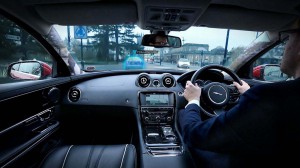Imagine having an uninterrupted view around your vehicle – no pillar or panels to obstruct your line of sight, especially when driving on a crowded city street or in heavy freeway traffic. That’s the idea behind the “360 Virtual Urban Windscreen” system Jaguar Land Rover is developing.
While still in prototype stage, the system takes Head-Up Display, or HUD, technology to the next level by embedding an LCD display screen in each of the car’s pillars. Each displays an image from outside the car using cameras that cover the vehicle’s blind spots. It would effectively create transparent pillars giving the driver an unobstructed view of the world around.
“Our ultimate aim is to reduce road accidents and enhance the urban driving experience,” explains Wolfgang Epple, JLR’s Director of Research and Technology. “If we can keep the driver’s eyes on the road ahead and present information in a non-distracting way, we can help drivers make better decisions in the most demanding and congested driving environments.”
The Virtual Windscreen system would rely on a tracking system that would be able to determine where the driver is looking, automatically turning on the appropriate display, say, when the driver looks left or right.
Epple says the system could be taken a step further by connecting it to the so-called Cloud. By linking up to a roadside infrastructure, it could be used to display additional information – fuel prices at a passing service station, for example, or the number of open parking spots in a garage.
“The connected car could also enhance navigation by advising the driver to turn left or right at more visible landmarks, such as pubs or shops, rather than just road signs or street names,” notes a statement from the British automaker.
(Jaguar adding AWD and manual transmission to popular F-Type. Click Here for the story.)
JLR is looking at other ways to use Head-Up Display to enhance onboard navigation. A growing number of vehicles now use HUD – which was first developed for military aircraft – to provide basic route guidance information. That might mean displaying an arrow on the windscreen to show when to make a turn. But the Indian-owned automaker is working on a potentially more intuitive approach it has dubbed “Follow-Me Ghost Car Navigation.”
A phantom car would be projected on the windshield that would essentially serve to guide the driver by making all the appropriate turns to reach their destination.
“Driving on city streets can be a stressful experience, but imagine being able to drive across town without having to look at road signs, or be distracted trying to locate a parking space as you drive by,” adds Epple. “We want to present all of this information on a Heads-Up Display in the driver’s eye-line, so the driver doesn’t have to seek it out for themselves and take their eyes off the road ahead.”
(Ford launching all-new version of its infotainment system, dubbed Sync 3. Click Here for the latest.)
Jaguar Land Rover isn’t saying when – or even if – it will bring the new system to market but Head-Up Display technology is finding increased use in a vehicle, as are other systems designed to overcome limits to visibility.
Nissan introduced a so-called Around View Monitor a few years back that creates a simulated birds-eye view of the vehicle to make it easier to park or pull out of a space. That technology is now being by a wide range of competitors. Rear-mounted radar technology powers Cross Traffic Alert systems that help a driver see vehicles approaching from the side when backing out of a parking space.
And radar, sonar and vision systems, including infrared cameras, help spot potential obstacles – whether cars, pedestrians or bicyclists — a motorist might miss, especially in crowded urban situations.
(Drivers want more high-tech features, finds new study. Click Here to learn more.)


I doubt this will help those who drive with their eyes closed or those typing text…
This does not sound like it was completely thought thru…